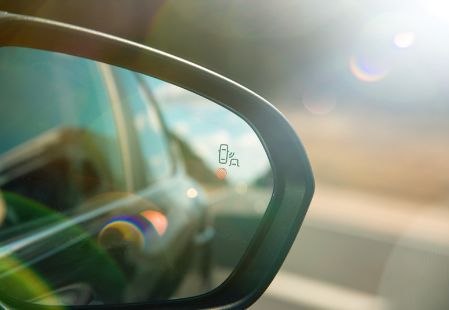Blind spot crashes are one of the most common types of auto accident, and many new cars and SUVs come equipped with blind spot monitors to help combat this issue. While they are not yet required, like backup cameras now are in all new vehicles sold in the U.S., they can be helpful in preventing crashes.
If you are wondering if it’s worth it to get a vehicle with a blind spot monitor or to install one in your current vehicle, our blog discusses what you need to know.
Watch: Gary Bruce discusses blind spot liability.
What is a Blind Spot Monitor?
The areas around your car that are not visible from your sideview or rearview mirrors, such as immediately behind the driver’s side and front passenger windows, are known as “blind spots.” They are dangerous because drivers can’t avoid crashes with other vehicles that they don’t know are there. If another vehicle is in your blind spot and you try to change lanes, you could crash into it and be held liable for the crash!
Blind spot monitors are safety features in cars that can detect when another vehicle is in your blind spot for you.
How Do Blind Spot Monitors Work?
Blind spot monitoring systems use sensors in a vehicle’s rear bumper and/or side mirrors to detect when another vehicle is approaching and from which side.
While the specifics can vary from manufacturer to manufacturer, they generally work like this: If another vehicle is approaching your blind spot, or if you activate your turn signal while another vehicle is in your blind spot, the blind spot monitoring system will issue a warning.
This is usually an indicator light coming on with a warning chime. Depending on the auto manufacturer, the indicator light is usually either on the sideview mirror itself or on the instrument panel.
How Well Do Blind Spot Monitors Work?
According to the Insurance Institute for Highway Safety, cars with blind spot monitoring systems are 21% less likely to get into injury-causing crashes. The research suggests if all vehicles were equipped with blind spot monitors, 50,000 crashes and 16,000 injuries could be prevented every year.
However, blind spot monitors are not 100% effective 100% of the time.
They usually have a minimum speed they can detect other vehicles approaching at, which means they are generally only useful on the highway. However, they also usually have a maximum speed they can detect, which means if another vehicle behind you is speeding, the blind spot monitor may not be able to detect it.
Blind spot monitors also have a difficult time detecting vehicles smaller than cars, which means they often struggle to detect motorcycles. According to AAA, blind spot monitors need 26% more time to determine if a motorcycle is in a blind spot than they do for a car.
This means if a driver is not waiting long enough for the blind spot monitor to read the area around the car before changing lanes, the blind spot monitor may not be useful.
Who’s Liable for a Crash If the Blind Spot Monitor Didn’t Work?
Blind spot monitors are not a substitute for checking your mirrors or looking over your shoulder before changing lanes or merging. They are supposed to be supplemental.
For example, if your blind spot monitor is activated and doesn’t issue a warning when you flip on your turn signal, that doesn’t mean you are free to go ahead and change lanes; you still need to check your mirrors and over your shoulder.
Drivers ARE liable for blind spot crashes, even when they have blind spot monitors installed in their vehicles. If your blind spot monitor was truly defective, the manufacturer may have some liability for the crash, but you would still also share liability for failing to check your blind spot yourself.
Related Reading: Are You Still Liable for a Collision If They Were in Your Blind Spot?
This doesn’t mean you are at-fault for any blind spot crash, however! If your blind spot monitor failed to detect the other vehicle because they were speeding, the driver of the other vehicle has liability for speeding, for example.
What is important is proving you do not have the majority of fault for the accident. According to Georgia law, as long as you are 49% or less at-fault, you can still recover compensation for injuries and vehicle repairs.
Were You Injured in a Blind Spot Crash That Wasn’t Your Fault? Call Gary Bruce.
Blind spot crashes are common because so many drivers choose to act negligently and make lane changes without looking or ever engaging their turn signals. These are basic safety precautions that every driver owes to themselves and all other drivers and passengers on the road.
If you or someone you love was hurt in a blind spot crash, contact our Georgia auto accident firm today for a free, no-obligation case consultation.
